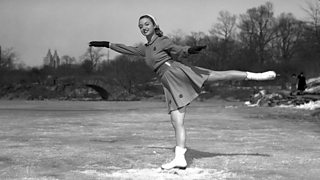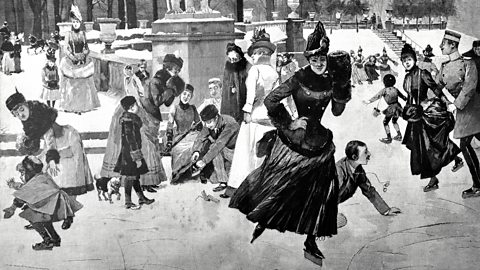Breaking the ice

Most of us aren’t in the right place to put our skates on and try natural ice this winter. But more and more towns, cities, and heritage attractions have opened seasonal synthetic rinks outdoors, fulfilling the same functions as frozen waters and grounds have done for centuries.
In Breaking the Ice on ����ý Radio 3, Seán Williams traverses painting and poetry, classical music and popular song, gliding through the centuries to bring us a brief history of lake skating.
Monochrome images © Getty Images
If Omicron didn’t coop us up in isolation over the festive season, we may have decided to get together outside – more so than is usual for this colder time of year. But one sociable winter activity that naturally takes place outdoors is ice skating. People have skated for fun across frozen lakes, waterways, and even fields since the earliest times. And more recently, around open-air, artificial rinks. They speeded and bumped along on bone, before slipping, sliding, and gliding on steel.
I may not have spent my own early years skimming the crackling surface of a local pond in Norfolk (the family dog falling through the ice was enough to put me off). I remember, though, meeting up as a teenager with friends from a Saturday drama club at the seasonal outdoor rink when it first came to Norwich. There, the ice was broken only in a conversational or, well, a flirty sense. Years later, while writing my doctorate on Romanticism, I put the books to one side and went on a date at a pop-up skating rink – a rendezvous that turned romantic only really in an effort to warm up. And then I sought to break out beyond the guard rails and civilised convention, into nature again. But for that I had to travel abroad – in Sweden, I holidayed as part of a skating party that serenely traversed through frosty, picturesque scenery at pace.

Yet the past is also a foreign country, they say. So for Sunday Feature, I skated back in time, and to the frozen continental plains of Europe. Although we have taken to the ice for millennia, skating scenes are especially striking since the Northern Renaissance – in other words, the early modern period in climates that were not so Mediterranean. The Bruegel family sketched crowded canals in 16th-century Flanders, full of ice-skaters.

A geological “little ice age” covered the North Atlantic in cooler weather in that era, and continued into the late 19th century. The cold snap was accompanied by vignettes of skaters in art, literature, and of course also music.
Émile Waldteufel’s The Skaters’ Waltz marks a crescendo in the popular pastime. Waldteufel had stood and watched Parisians socialising and skating in a city park, in 1882.
A century earlier, Romanticism formed an influential, if unusual waypoint along that historical journey. So it plays a major part of our Sunday Feature. And for me, skating proved a relevant procrastination during those frustrated doctoral years working on the Romantics – even if I wouldn’t end up emulating William Wordsworth, who (according to his poetry) preferred his own company on Lake Windermere.
Wistful and wintery arty types might think of The Skating Minister, too: a Scottish portrait from the 1790s. It paints a sublime picture of pensive and poised solitude on the ice. The outline for both these images came from an earlier German poet, Friedrich Klopstock, in the late 1760s. His words introduced the skater to Europe as an original genius, shunning the candles of the ballroom for the crisp night air. Klopstock extolled the creativity of skating that soon disappears unless preserved in poetry, or art. For him, the new lines in the ice are metaphors for the masterstrokes of the quill (or brush). Poets such as Goethe and Wordsworth followed suit. In fact, Wordsworth wrote his skating episode in The Prelude after visiting Klopstock, and then touring German towns with skating rinks in the winter of 1798.


Cavorting, conversing and dancing...
Seán Williams heads for the ice to introduce a short history of social skating.
And yet, despite the elegiac tone of such odes to the ice, the idea of contemplative isolation reads as implausible to me. As I look at The Skating Minister, I wonder what would happen if we zoomed out a little. I imagine groups of skaters speeding around, just outside the frame. I think the pious minister actually teeters on the edge of incipient pomposity. Isn’t there slapstick humour waiting in the wings, about to undermine this scene of apparent perfection? The comic potential of real life can soon crash into the ideals of art. The slipperiness of both ice and of our own existence mean we often land clumsily, with a bump.
I don’t mean to sound cynical about Romantic idealism having cracked. Nor churlish in trying to trip great writers up. But it’s ironic that, in time, words were taken out of the mouths of these poets who sought solitude and shunned convention, and they were written into pocket-guides to sociable skating.

Klopstock and his kind were anthologised in popular 19th-century handbooks, for motivation or to be read aloud together during an outing on the ice! All alongside diagrams or descriptions of different moves to try out. And there is surely something heart-warming in the return to more socially-engaged skating episodes, beyond Romantic individuality, as the 19th century set in.
In the new century across Europe, class structures had thawed – but we know they didn’t melt away. Optimism stumbled. There’s a sentimental and historically transitional skating scene of this sort in a German novel from around 1805, by the popular author Jean Paul (who has since undeservedly fallen out of favour). The episode in Walt and Vult is about two twins who vie for the attention of Wina – a woman who is already engaged, and to a count at that. Wina and her friends are out skating on New Year’s Eve, on a small pond in moonlight, and by a classically-styled rotunda that is a shelter for deer. The worldly Vult rents skates and flirts – let’s play lovers, he says, to which one woman replies, “While on the ice, I’m game.” The cerebral Walt, meanwhile, daren’t skate, but reads his own poetry from the bank as others play music. Moved by the impromptu performance, he finally ventures onto the ice for a brief moment of beauty – before it’s suddenly time for the women to go home. A servant reminds the twins of their lower social status back on dry land. Ice offers us moments to act more freely, yet only as a temporary state.
The changing elements can also remind us of what’s important, and help us change our mind about people. The sisters Jo and Amy in Louisa May Alcott’s Little Women are reconciled in a scene from 1868 – Jo doesn’t want to be joined by her younger sibling on the lake, so doesn’t warn Amy about thin ice out of spite. Jo is then stricken with guilt when Amy falls into the freezing water, resolving to be less angry in future. Just as ice can emphasise either clumsiness and the comic in life, or raw corporeal attraction, the fact that our bodies are at the mercy of ice’s slipperiness can mean we put our differences aside and lend each other a hand. We can tempt our fate, and test our friendships and relationships – old and new. And with Romanticism behind us, I’d say it’s better not to be alone on the ice.

-
![]()
The Sunday Feature
In-depth documentaries which explore music, history, science, philosophy, film, visual arts and literature.
-
![]()
Pooch Epistles – A Little History of Lapdogs
Seán Williams on mankind's little friend, from the 18th century to the present day.
-
![]()
Why does luxury provoke social and political discord in every age?
Seán Williams takes a first-class journey through the contradictions of luxury.
-
![]()
Seriously...
Seriously is home to the world’s best audio documentaries and podcast recommendations.




